Neutrinos: an introduction Understand article
What do continental drift, nuclear power stations and supernovae have in common? Neutrinos, as Susana Cebrián explains.
What are neutrinos?

Mark Tiele Westra
Neutrinos, meaning ‘little neutral ones’, are everywhere, all around us. These tiny elementary particles travel through space at close to the speed of light and have no charge. They were once thought to have no mass either, but scientists now suggest that they do have a mass; it is estimated to be less than a billionth of the mass of a hydrogen atom, but the research continuesw1.
The existence of neutrinos, among the most abundant particles in the Universe, was first postulated by Austrian physicist Wolfgang Pauli in 1930 to explain observations of radioactive beta decay. It was not until the first nuclear power stations were built, though, that a sufficiently high flux of neutrinos (actually their antiparticles, antineutrinos; see Landua & Rau, 2008, for more information on antiparticles) from decaying fission fragments was available to confirm their existence. In 1956, Clyde Cowan and Frederick Reines built two large water-filled tanks underground, mere metres away from the nuclear power plant at Savannah River near Aiken, South Carolina, USA, in which the antineutrinos interacted with the water’s protons (see diagram below). Frederick Reines was awarded the Nobel Prize in Physics in 1995w2 for this experiment. Clyde Cowan could not share the prize, because he had passed away in 1974.
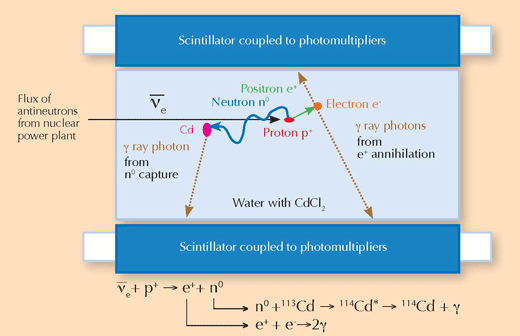
Image courtesy of Susana Cebrián
Neutrinos come in three types or flavours, according to the standard model of particle physics (see image below): the electron neutrino, muon neutrino, and tau neutrino, which have all been confirmed experimentally. For the detection of the muon neutrino, Leon M Lederman, Melvin Schwartz and Jack Steinberger were awarded the Nobel Prize in Physics in 1988w2.
A fourth, ‘sterile’ type has been proposed, which is immune to the weak force of the standard model, and recent data including a refined calculation of measurements performed at the Institut Laue-Langevinw3 in Grenoble, France, in the 1980s support this idea (Hand, 2010; Reich, 2011). Were sterile neutrinos to be found, a new realm of physics beyond the standard model would open up.
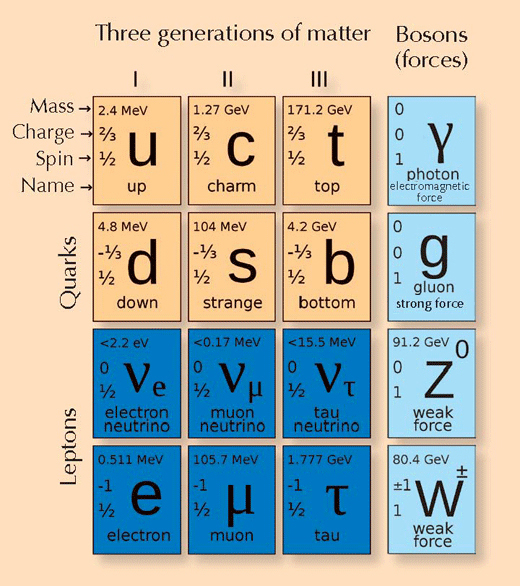
Matter particles come in two different types, leptons and quarks, forming a set of 12 particles, divided into three families, each consisting of two leptons (one of which is a neutrino) and two quarks. Matter particles can ‘communicate’ with each other in different ways by exchanging different types of messenger particles named bosons (a different boson for each of the fundamental interactions), which can be imagined as little packets of energy with specific properties. The masses of certain particles are still being investigated by the scientific community; these are values from 2008
Image courtesy of PBS NOVA; image source: Wikimedia Commons
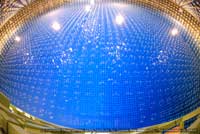
nearly full of water, seen
from above. Click to enlarge
image
Image courtesy of Kamioka
Observatory, ICRR (Institute
for Cosmic Ray Research), The
University of Tokyo
Even the three confirmed types of neutrinos are special: they oscillate from one flavour to another – electron, muon and tau neutrinos change from one to another. This phenomenon was first observed in 1998 by the Japanese Super-Kamiokande experimentw4, in which muon neutrinos generated in the atmosphere were found to ‘disappear’, presumably into tau neutrinos. A recent experiment has now successfully observed such an event from the other perspective – as an appearing tau neutrino rather than a disappearing muon neutrino: after three years in which a beam of muon neutrinos was released at CERNw5 in Geneva, Switzerland, a tau neutrino was detected in 2010 by the OPERA detector at the Gran Sasso National Laboratoryw6 in Italy, 730 km away (see image below).
The detection of the oscillations also solved a 40-year-old mystery: scientists had always found many fewer electron neutrinos arriving from the Sun than expected. In 2001, the Solar Neutrino Observatoryw7 in Canada demonstrated that they changed into neutrinos of other flavours on their way to Earth (Bahcall, 2004). Further experiments to analyse neutrino oscillations are underway, for example in France and Japan, where accelerators and nuclear power stations provide large numbers of antineutrinos for observationw8.
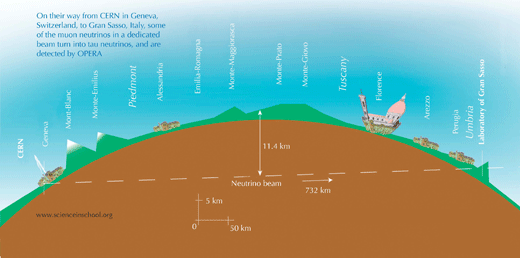
Image courtesy of CERN
Where do neutrinos come from?
Neutrinos first originated some 14 billion (14 x 109) years ago, 10-43 seconds after the Big Bang. A mere second later, they were already rapidly moving away from the rest of the hot and dense primary particle soup; scientists are still seeking to detect neutrinos that survive from the Big Bang.
It is neutrinos’ weak interaction with matter that makes them almost impossible to detect, but it is also what makes them of interest to scientists. Unlike most other particles, neutrinos are able to escape from dense regions such as the core of the Sun or the Milky Way, and can they travel long distances from far-away galaxies without being absorbed, carrying information about these areas. In this sense, neutrinos are cosmic messengers, and neutrino astronomy is becoming increasingly important.
So far, only two sources of extraterrestrial neutrinos have been observed: the Sun and supernovae. Raymond Davis Jr and Masatoshi Koshiba won the third neutrino Nobel Prize in Physics in 2002w2 for their detection of solar and supernova neutrinos. Like other stars, the Sun emits electron neutrinos at several steps of the process by which light nuclei fuse into heavier ones (see image below, and to learn more, see Westra, 2006, and Boffin & Pierce-Price, 2007); more than 1010 solar neutrinos hit a square centimetre of Earth every second. Unlike photons, which take about 100 000 years to travel from the core of the Sun to its outer photosphere before speedily travelling to Earth, neutrinos released in the same fusion process do the entire trip in a mere 8 minutes. This is why solar neutrinos are useful messengers carrying information about the current fusion processes inside the Sun, such as the chemical composition of its corew9.
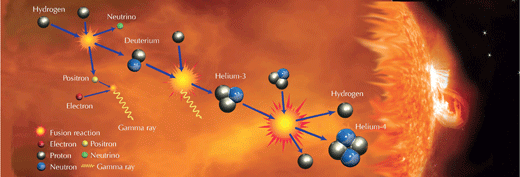
Image courtesy of Mark Tiele Westra
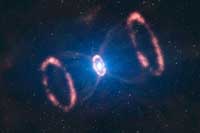
material around supernova
SN1987A: two outer rings,
one inner ring and the
deformed, innermost
expelled material
Image courtesy of ESO /
L Calçada
Supernova neutrinos are the result of the violent end of some stars, which explode and produce even more neutrinos than photons (see Székely & Benedekfi, 2007): in 1987, several detectors registered an unusually strong signal (several events within a few seconds, as opposed to the usual frequency of about one per day), attributed to neutrinos from supernova SN1987A in the Large Magellanic Cloud. To allow astronomers to prepare to observe these events, several neutrino detectors are now linked together as the Supernova Early Warning Systemw10, because during these stellar explosions, the neutrinos are released before the photons that the astronomers seek to detect.
Astronomers, however, are not the only scientists interested in neutrino detectors. On Earth, both natural and artificial neutrino sources exist: radioactive materials from inside Earth can undergo beta decay, producing geo-neutrinos. In addition, nuclear fission reactors produce neutrinos, and dedicated particle accelerators are being used as neutrino sources for research. These are interesting to particle physicists, of course, to further characterise neutrinos, but also to earth scientists and maybe even politicians (see ‘Neutrinos as nuclear police’ and ‘Powering Earth’).
Finally, when cosmic rays hit Earth’s atmosphere, atmospheric neutrinos are emitted as decay products of pions and muons. This most abundant source of naturally occurring neutrinos on Earth is a nuisance to neutrino astronomers (see ‘How to detect neutrinos’, below), who are interested in neutrinos that originate in outer space, but it provides neutrino physicists with another means of studying their favourite particles.
How to detect neutrinos
Neutrinos are very useful for studying astronomical and cosmological phenomena, and neutrino detectors are being built worldwide, deep underground to filter out the ‘noise’ of other particles. The recently finished IceCubew11 is the largest detector yet: a cubic kilometre of ice at the South Pole, acting as a telescope to search for neutrinos from astrophysical sources (see images below). When a neutrino hits a proton of Antarctic ice, a muon is released. Like any charged particle travelling at more than the speed of light in a specific medium (though less than the speed of light in vacuum), the muon will generate a conical trail of blue light – Cherenkov radiation, the photonic equivalent of a supersonic boom, which can also be seen in some nuclear reactors.
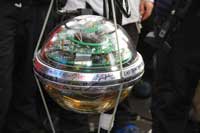
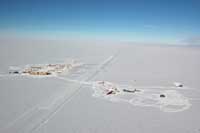
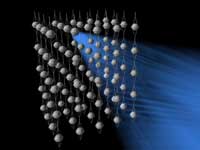
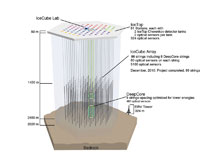
Images courtesy of NSF
Thousands of optical sensors, in a three-dimensional grid 1.5-2.5 km deep in the ice, detect this light; combined, the data can be used to determine the energy of the neutrino and the direction it came from. To distinguish muons that are generated from cosmic neutrinos from the millions more muons that are produced by cosmic rays in the atmosphere above the detector, IceCube uses Earth as a filter, only looking at muons that come from underground. Neutrinos are the only particles able to penetrate the Earth unhindered, so any muon coming from that direction must have been newly generated in the detector from a cosmic neutrino.
Other detectors use different materials and strategies – but all put as much material in the neutrinos’ way as possible, trying to make them interact and reveal themselves.
Neutrinos as nuclear police
Detection of nuclear weapons and material is important for many reasons, including the prevention of nuclear proliferation and terrorism. Scientists now propose that cubic-metre antineutrino detectors could be used to non-intrusively monitor and safeguard nuclear reactorsw12.
At present, reactors are monitored indirectly (for example using satellites, gas and dust emissions, and seismic and infrasound signatures for weapons testing), which can result in misleading data. Neutrino detectors would provide real-time information about the reactor core power and possibly even its isotopic composition. An array of about 500 such detectors worldwide would be able to calculate the power output of individual reactors, allowing the detection of clandestine nuclear weapons testing.
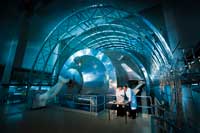
detector tank is filled with
water. Click to enlarge image
Image courtesy of Kamioka
Observatory, ICRR (Institute for
Cosmic Ray Research), The
University of Tokyo
Powering Earth
Neutrinos are also detected in geophysics. Natural radioactive decay of uranium, thorium and potassium in Earth’s crust and mantle sustains the flow of molten material in convective currents, which drive continental drift, seafloor spreading, volcano eruptions and earthquakes.
There are several models for this decay, depending on the composition of Earth’s crust. Geo-neutrinos produced during decay may help answer the question of crust composition. Geo-neutrinos were first detected in 2005 by the KamLANDw13 experiment in Japan, although an abundance of nuclear power stations limited the studies, because the antineutrinos they release have similar energetic signatures to those of geo-neutrinos. In 2009, an international team from the Borexino projectw6, w14 was more successful because there are fewer nuclear power stations nearby, so eventually, statistically significant numbers of geo-neutrinos should be collected to determine the relative amounts of uranium, thorium and potassium.
In the time that you have been reading this article, about 10 000 000 000 000 000 neutrinos have passed through you without your noticing. Tiny, yet with the power to confirm or overthrow a number of scientific theories.
Acknowledgement
The editors would like to thank Dr Christian Buck, neutrino physicist from the Max-Planck-Institut für Kernphysik (Max Planck Institute for Nuclear Physics), Heidelberg, Germany, for advice in developing the article.
References
- Bahcall J (2004) Solving the mystery of the missing neutrinos. Nobelprize.org. http://nobelprize.org/nobel_prizes/physics/articles/bahcall
- Boffin H, Pierce-Price D (2007) Fusion in the Universe: we are all stardust. Science in School 4: 61-63.
- Hand E (2010) Hunt for the sterile neutrino heats up. Nature 464: 334-335. doi: 10.1038/464334a
- Download the article free of charge here, or subscribe to Nature today: www.nature.com/subscribe
- Landua R, Rau M (2008) The LHC: a step closer to the Big Bang. Science in School 10: 26-33.
- Reich ES (2011) The amazing disappearing antineutrino. Nature. doi: 10.1038/news.2011.202
- Székely P, Benedekfi O (2007) Fusion in the Universe: when a giant star dies... Science in School 6: 64-68.
- Westra MT (2006) Fusion in the Universe: the power of the Sun. Science in School 3: 60-62.
Web References
- w1 – Scientists from the University College of London have estimated the mass of the neutrino: www.ucl.ac.uk/news/news-articles/1006/10062204
- Hopes for the most accurate measurements yet lie with the KATRIN experiment, which is in Karlsruhe, Germany: www-ik.fzk.de/~katrin
- w2 – Read about the Cowan and Reines experiments here: http://library.lanl.gov/cgi-bin/getfile?00326606.pdf
- To find out more about the Nobel Prizes in Physics 1988, 1995 and 2002, see: http://nobelprize.org/nobel_prizes/physics/laureates
- w3 – The Institut Laue-Langevin operates one of the most intense neutron sources in the world. It is a member of EIROforum, the publisher of Science in School. See: www.ill.eu
- w4 – For more information on the Japanese Super-Kamiokande experiment, see: www-sk.icrr.u-tokyo.ac.jp/sk/index-e.html
- w5 – To find out more about CERN, the world’s largest particle physics laboratory and one of the eight members of EIROforum, the publisher of Science in School, see: www.cern.ch
- To read more about the successful detection of a muon neutrino turned into a tau neutrino in CERN’s press release, see: http://public.web.cern.ch/press or use the direct link: http://tinyurl.com/64cvhr5
- Or watch a video on the topic: www.youtube.com/watch?v=M3aB_zUZ1c8
- w6 – The Gran Sasso National Laboratory in Abruzzo near L’Aquila, Italy, is the largest underground laboratory in the world for experiments in particle physics, particle astrophysics and nuclear astrophysics, including the OPERA and Borexino experiments. To learn more, see: www.lngs.infn.it
- w7 – For more information about the Canadian Solar Neutrino Observatory experiment, see: www.sno.phy.queensu.ca
- w8 – In France and Japan, detectors have been installed to further analyse neutrino oscillations. See: http://doublechooz.in2p3.fr and http://jnusrv01.kek.jp
- w9 – To find out more about current solar neutrino research, see: http://arxiv.org/pdf/0811.2424
- w10 – The Supernova Early Warning System website can be found here: http://snews.bnl.gov
- w11 – For more information about ongoing research projects at IceCube, see: http://icecube.wisc.edu
- Olivier Hainaut from the European Southern Observatory (ESO), the world’s most productive astronomical observatory, which is a member of EIROforum, talked to the IceCube scientists during the 24-h live webcast ‘Around the world in 80 telescopes’ during the International Year of Astronomy 2009. Start watching the online video from minute 1:27: www.eso.org/public/videos/10msouthpole
- For the ESO website, see: www.eso.org
- For further astronomy resources, see: Starr C, Harwood R (2009) Education resources for the International Year of Astronomy. Science in School 13.
- w12 – To learn more about the idea of detecting secret fission reactors using neutrinos, see: http://physicsworld.com/cws/article/news/44411
- w13 – If you would like to find out more about the KamLAND experiment in Japan, see: http://kamland.lbl.gov
- w14 – Find out the latest about the Borexino experiment: http://borex.lngs.infn.it
Resources
- The Booster Neutrino Experiment and Interactions.org have produced good overview brochures on neutrinos, freely available online. See: www-boone.fnal.gov/about/nusmatter (Neutrinos Matter) and www.interactions.org/pdf/neutrino_pamphlet.pdf (Neutrino Odyssey)
- The IceCube project website hosts a wonderful teaching activity on ‘popcorn neutrinos’, in which students can investigate the concepts behind beta decay. See: www.icecube.wisc.edu or use the direct link: http://tinyurl.com/45ytuq7
- For slides of three talks on neutrino research for school students, available in German, see: www.mpi-hd.mpg.de/hfm/wh/pams/PamS0708.htm
- Particle Adventure is a fun interactive online tour of particle physics: http://particleadventure.org
- The Contemporary Physics Education Project offers student and teacher worksheets in English and Spanish for classroom activities on particle physics, including one on conservation laws, following Pauli’s footsteps in postulating the neutrino (Activity 5). See: www.cpepweb.org/Class_act.html
- The UK Science and Technology Council has compiled a resource guide for teaching particle physics. See: www.stfc.ac.uk/Public and Schools/2563.aspx
Institutions
Review
Neutrinos are strange particles – small but fascinating. This article describes their origin, properties and detection in an accessible way and with sound facts. It makes good background reading for physics teachers, but can also be a starting point for students doing a presentation project on the topic or to stimulate further discussions, e.g. about particle physics in general, the standard model, detector physics, CERN, astrophysics or radiation.
The article is mainly useful for physics lessons, but it contains links to earth science. To make the topic accessible to younger students (about the age of 14) as well, I would suggest the teacher selects parts of the article to discuss.
Gerd Vogt, Austria





